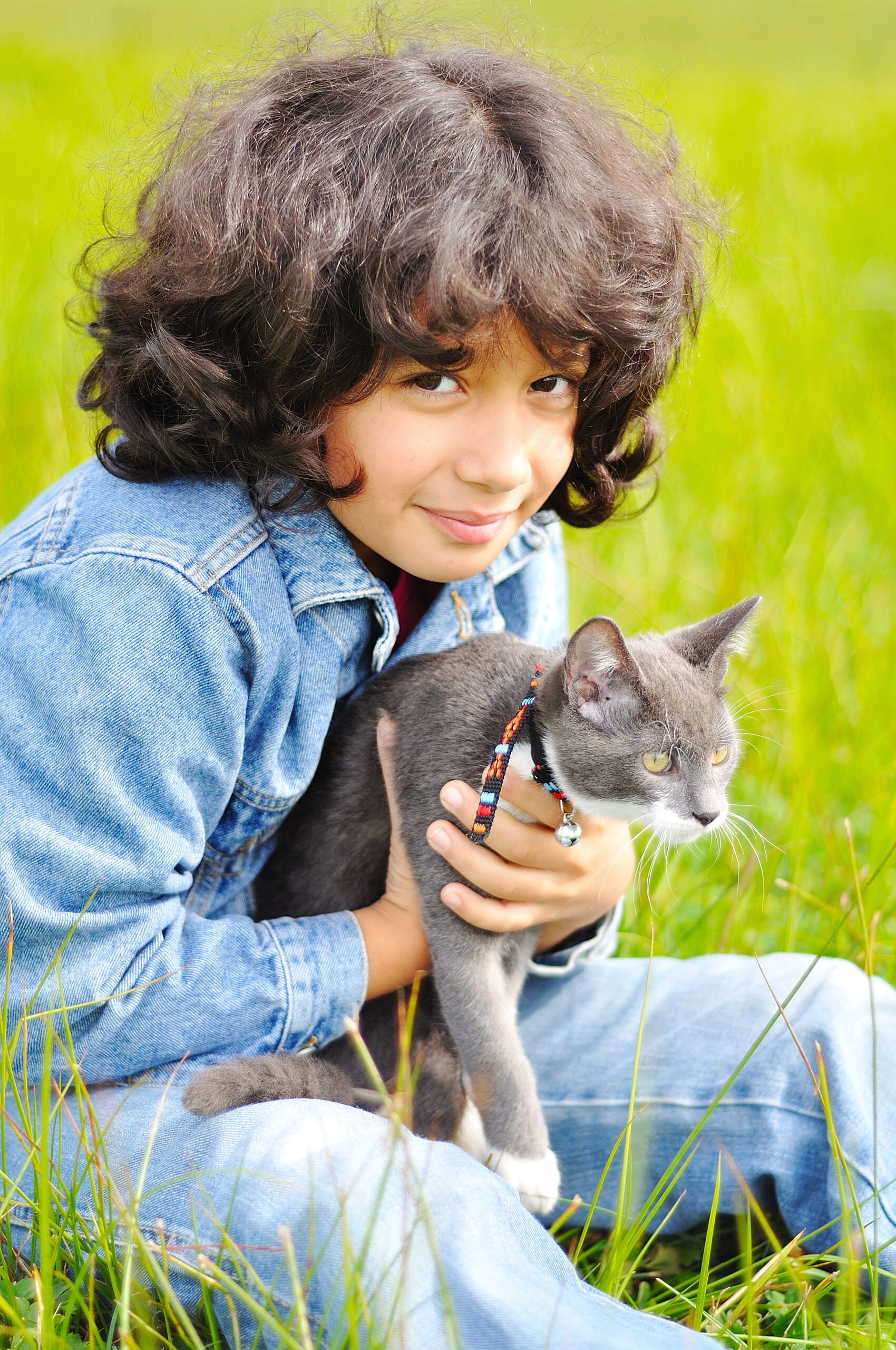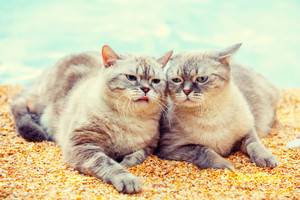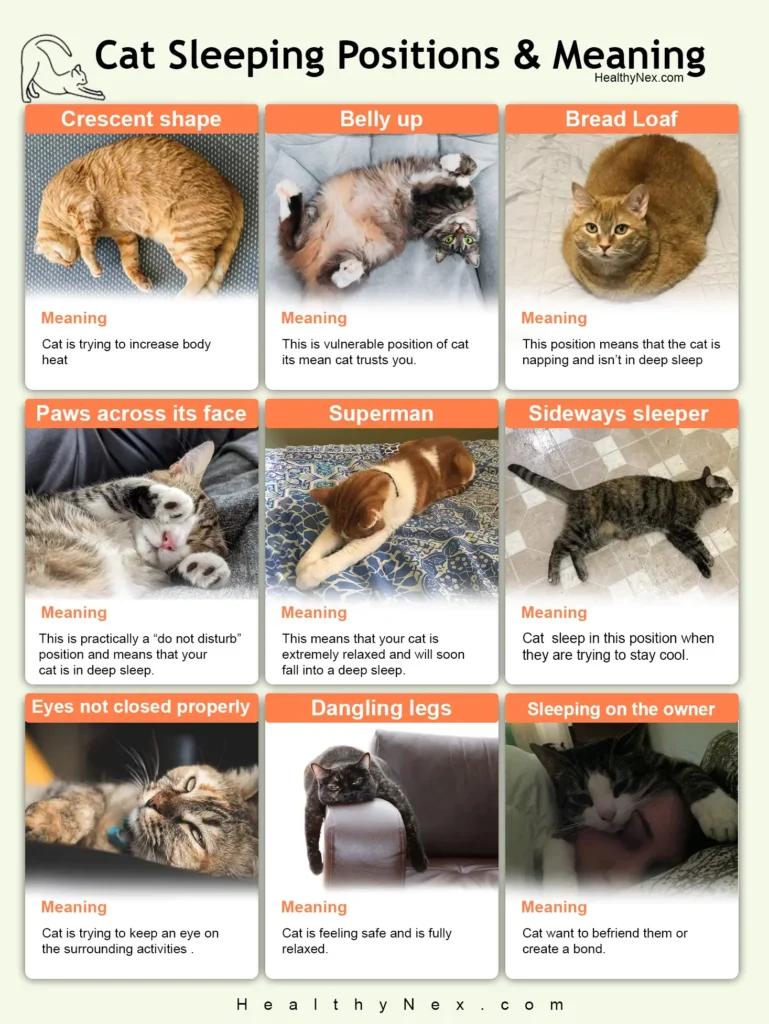Cat Behavior
5 Common Cat Behaviors and How to Understand Them
Cats are fascinating creatures that can be mysterious at times. They have their own unique personalities, quirks, and behaviors that often leave us scratching our heads in confusion. In this article, we will explore five common cat behaviors and how you can understand them better.
Introduction to Common Cat Behaviors
One of the most important things to remember when it comes to understanding your feline friend is that cats are individuals with distinct personalities. Just like humans, they may exhibit certain traits more prominently than others. However, there are some general behavior patterns that many cats share. These include:
1. Aggression – Cats may display aggressive behavior towards people or other animals if they feel threatened or anxious. This could involve hissing, growling, swiping, or biting.
2. Meowing and Other Sounds – Cats use a variety of sounds to communicate with us, including meows, purrs, chirps, and growls. Learning what these different sounds mean can help you understand your cat’s needs and emotions better.
3. Scratching and Clawing – Scratching and clawing is a natural behavior for cats as it helps them maintain healthy nails and mark their territory. It’s essential to provide your cat with appropriate scratching surfaces to prevent damage to furniture and household items.
4. Toilet Training Your Cat – Litter box basics are crucial for keeping your cat happy and healthy. Make sure to choose the right litter, keep the box clean, and locate it in an easily accessible area.
5. Playtime with Your Feline Friend – Playtime is vital for your cat’s physical and mental well-being. Provide plenty of toys and engage in play sessions regularly to strengthen your bond and give your cat an outlet for exercise and stimulation.
Understanding Aggression in Cats
Aggression is one of the most common concerns among cat owners. If your cat displays aggressive behavior towards people or other animals, it’s essential to identify the cause and address it appropriately. Some possible reasons for aggression include fear, anxiety, pain, territoriality, or overstimulation. Consider scheduling a visit with your veterinarian to rule out any underlying medical issues and discuss strategies for managing your cat’s behavior.
Exploring the Meaning of Meowing and Other Sounds
Meowing is perhaps the most recognizable sound made by cats, but it’s not always easy to interpret its meaning. A loud, insistent meow might indicate that your cat wants food or attention, while a soft, plaintive mew might signal distress or discomfort. Pay close attention to the context and tone of your cat’s vocalizations to gain insight into their needs and emotions.
The Importance of Scratching and Clawing
Scratching and clawing is a normal part of a cat’s behavior, but it can also cause significant damage to furniture and household items. By providing your cat with appropriate scratching surfaces, such as a designated scratching post or pad, you can redirect their scratching behavior away from unwanted areas.
Toilet Training Your Cat: Litter Box Basics
Litter box training is critical for keeping your cat healthy and content. Choose a location that’s easily accessible and private, provide enough litter boxes (one per cat plus one extra), and make sure to scoop daily and replace litter frequently.
Playtime with Your Feline Friend
Playtime is essential for your cat’s physical and mental well-being. Provide plenty of toys, including both interactive and solo options, and engage in regular play sessions to strengthen your bond and give your cat an outlet for exercise and stimulation.
Socializing Your Cat with Other Animals and People
While cats are typically solitary animals, socialization can help them develop confidence and adaptability around new situations and environments. Gradually expose your cat to new experiences and introduce them to new animals or people slowly and calmly.
Healthy Eating Habits for Your Cat
A balanced diet is key to keeping your cat healthy and thriving. Offer a high-quality commercial cat food, avoid table scraps, and monitor portion sizes to ensure optimal weight maintenance.

Signs of Illness or Discomfort in Cats
As with all animals, cats may show signs of illness or discomfort through changes in behavior or appearance. Keep an eye out for symptoms such as lethargy, loss of appetite, vomiting, diarrhea, sneezing, or runny eyes/noses. Consult with your vet promptly if you notice any concerning signs.
Conclusion: Tips for a Happy, Healthy Cat
By understanding your cat’s behavior and meeting their basic needs, you can create a safe, comfortable environment where they can thrive. Remember to schedule routine checkups with your vet, offer plenty of opportunities for play and enrichment, and shower your furry companion with love and affection.
Socializing Your Cat: The Benefits of a Well-Adjusted Feline Friend
Introduction to Socializing Your Cat
Having a well-socialized cat can make all the difference in your household. A cat that is comfortable around people and other animals will be more confident, outgoing, and less prone to anxiety or aggression. However, socialization doesn’t happen overnight – it takes time and effort to help your feline friend become accustomed to new situations and stimuli. In this blog post, we’ll explore some tips for successfully socializing your cat and reaping the benefits of having a well-adjusted feline companion.
The Importance of Playtime and Exercise for a Well-Adjusted Feline Friend
One key component of socializing your cat is providing plenty of opportunities for playtime and exercise. Cats need mental and physical stimulation to stay healthy and happy, so investing in toys, scratchers, and climbing structures can go a long way towards helping them develop their natural instincts and behaviors. Additionally, regular play sessions with you or another family member can strengthen your bond and build trust between you and your cat.
Understanding Your Cat’s Body Language and Communication Needs
Another important aspect of socializing your cat is understanding their body language and communication needs. For example, cats often use tail movements, ear positions, and vocalizations to express themselves. By learning how to interpret these signals, you can better understand what your cat is trying to communicate and respond appropriately. This can also help prevent misunderstandings or conflicts with other pets or humans in your home.
Tips for Successful Cat Training and Behavior Modification
Finally, successful cat training and behavior modification requires consistency, patience, and positive reinforcement. Rather than using punishment or force, focus on rewarding good behavior with treats, praise, or attention. It may take time to see results, but with consistent effort, you can teach your cat new skills and modify unwanted behaviors.
Conclusion
In conclusion, socializing your cat can have numerous benefits, including improved confidence, reduced stress and anxiety, and stronger bonds with human companions. By providing ample opportunity for playtime and exercise, understanding your cat’s body language and communication needs, and utilizing positive reinforcement techniques for training and behavior modification, you can set your cat up for success and enjoy many years of happiness together.
5 Common Cat Behaviors and How to Understand Them
Cats are fascinating creatures that can be mysterious at times. They have their own unique personalities, quirks, and behaviors that can leave us scratching our heads in confusion. In this article, we will explore five common cat behaviors and how you can understand them better.
Introduction to Common Cat Behaviors
Understanding Aggression in Cats
Exploring the Meaning of Meowing and Other Sounds
The Importance of Scratching and Clawing
How to Handle Litter Box Issues
Tips for Training Your Cat
Encouraging Socialization with Other Pets or People
Maintaining a Healthy Diet and Environment
Signs of Illness or Distress to Watch Out For
Conclusion: Wrapping Up Common Cat Behaviors
1. Introduction to Common Cat Behaviors
When it comes to understanding cats, one thing is clear – they are not small dogs! While both species belong to the animal kingdom, there are significant differences between these two animals. One major difference is their behavior. Unlike dogs who tend to be more social and outgoing, cats are often independent and aloof. However, despite their seemingly unpredictable nature, cats do exhibit certain behaviors that can help us understand them better. Here are some common cat behaviors that you may observe:
2. Understanding Aggression in Cats
Aggressive behavior in cats can stem from various reasons such as fear, territoriality, or even medical issues. If your cat suddenly becomes aggressive towards people or other pets, it’s essential to identify the cause before taking any action. Firstly, rule out any underlying health problems by visiting your vet. Once you eliminate physical causes, consider environmental factors like changes in routine or introducing new pets into the household. You could also try desensitizing your cat through positive reinforcement training techniques. Remember, aggression should never be ignored or dismissed as “normal” feline behavior.
3. Exploring the Meaning of Meowing and Other Sounds
Meowing is perhaps the most recognizable sound made by cats. But did you know that meows aren’t always an indication of hunger? In fact, different types of meows can signify different things. A loud, shrill meow might mean your cat wants attention while a soft, gentle meow could indicate pain or discomfort. Additionally, cats use body language and vocalizations to communicate with each other. Pay close attention to contextual clues when interpreting your cat’s sounds.
4. The Importance of Scratching and Clawing
Scratching and clawing are natural behaviors for cats. It helps them maintain healthy nails, mark territory, and express frustration. However, if your cat is destroying furniture or carpets, it’s time to take action. Provide your cat with appropriate scratching surfaces like vertical posts or horizontal shelves. Trim their nails regularly and offer plenty of playtime opportunities to reduce stress levels.
5. How to Handle Litter Box Issues
Litter box issues are among the top reasons why cats get rehomed or abandoned. Before assuming your cat has bad habits, check for possible underlying causes. Is the litter box clean enough? Are there enough boxes per number of cats? Does your cat prefer privacy during elimination? Address these concerns first before attempting to train your cat. Positive reinforcement methods work best, so reward your cat for using the litter box correctly.
6. Tips for Training Your Cat
Training your cat doesn’t have to involve complicated techniques. Start with basic commands like ‘come,’ ‘stay,’ and ‘sit.’ Use positive reinforcement methods like clicker training and treats to encourage good behavior. Consistency and repetition are key when teaching your cat anything new. Don’t forget to make training sessions fun and enjoyable for both you and your furry friend.
7. Encouraging Socialization with Other Pets or People
Socialization is crucial for kittens but can still benefit adult cats too. Introduce your cat gradually to new situations and environments. Allow them to approach new people or pets on their terms and provide safe spaces where they can retreat to if needed. Regular exposure to friendly humans and animals can help prevent anxiety and aggression later down the line.
8. Maintaining a Healthy Diet and Environment
A balanced diet rich in protein and fatty acids promotes optimal health in cats. Feeding your cat a high-quality commercial food reduces the risk of obesity, dental issues, and digestive problems. Keeping your home environment clean and well-maintained also contributes to overall health. Providing your cat with access to fresh water, regular grooming, and exercise can further enhance their quality of life.
9. Signs of Illness or Distress to Watch Out For
As attentive pet parents, it’s vital to recognize signs of illness or distress in your cat. Some common symptoms include lethargy, loss of appetite, weight loss, vomiting, and diarrhea. If you notice any unusual behavior or physical changes, consult with your veterinarian immediately. Early detection and treatment can save lives.
10. Conclusion: Wrapping Up Common Cat Behaviors
Understanding common cat behaviors requires observation, empathy, and knowledge. By providing your cat with a comfortable living space, nutritious food, and plenty of love and affection, you can create a strong bond built on trust and respect. Whether you’re dealing with aggression, litter box issues, or simply trying to understand your cat’s meows, remember that patience, consistency, and positivity go a long way in fostering a harmonious relationship with your feline companion.
5 Common Cat Behaviors and How to Understand Them
Cats are fascinating creatures that can be mysterious at times. They have their own unique personalities, quirks, and behaviors that can leave us scratching our heads in confusion. In this article, we will explore some of the most common cat behaviors and how you can understand them better.
Introduction to Common Cat Behaviors
Understanding Aggression in Cats
Exploring the Meaning of Meowing and Other Sounds
The Importance of Scratching and Clawing
How to Handle Litter Box Issues
Tips for Training Your Cat
Encouraging Socialization with Other Pets or People
Maintaining a Healthy Diet and Environment
Signs of Illness or Distress to Watch Out For
Conclusion: Wrapping Up Common Cat Behaviors
1. Introduction to Common Cat Behaviors
Let’s start by exploring some of the most common cat behaviors you may observe. Some of these include:
Scratching furniture or walls
Hiding under beds or tables
Excessive grooming
Biting or swatting at people or objects
Jumping on counters or shelves
These behaviors are all normal for cats but can sometimes indicate underlying issues such as stress, anxiety, or boredom. By understanding your cat’s behavior, you can create a more comfortable environment for them and prevent any negative behaviors from escalating.
2. Understanding Aggression in Cats
Aggressive behavior is often one of the most concerning for pet parents. If your cat suddenly becomes aggressive towards humans or other animals, it could be due to several factors including fear, pain, or territoriality. To address aggressive behavior, it’s essential to identify the cause first. Once you know what’s causing the aggression, you can take steps to reduce or eliminate it. This might involve making changes to your cat’s routine, providing them with more space or resources, or seeking professional help from a veterinary behaviorist.
3. Exploring the Meaning of Meowing and Other Sounds
Meowing is perhaps the most well-known sound made by cats. However, there are many different types of meows, each conveying a specific message. For example, a loud, high-pitched meow might mean “I want food,” while a soft, low-pitched meow might signify “I need attention.” It’s crucial to pay close attention to your cat’s vocalizations to understand what they’re trying to communicate. Additionally, body language also plays an important role in understanding your cat’s mood or intentions.
4. The Importance of Scratching and Clawing
Scratching and clawing are natural behaviors for cats. Unfortunately, many pet parents discourage these behaviors because they damage household items like carpeting or furniture. Instead of punishing your cat for scratching, provide them with appropriate surfaces to use instead. You can purchase scratching posts or pads designed specifically for cats, or even make your own using cardboard tubes or rope. Providing your cat with suitable outlets for scratching not only saves your belongings but also helps keep their nails healthy and trimmed.
5. How to Handle Litter Box Issues
Litter box problems are another common issue faced by cat owners. These might include urinating outside of the litter box, defecating elsewhere, or avoiding the litter box altogether. Before assuming your cat has a medical problem, consider whether there are environmental factors contributing to the issue. For instance, the location of the litter box might be inconvenient for your cat, or the type of litter used might be unappealing. Addressing these concerns can often resolve litter box issues quickly.
6. Tips for Training Your Cat
While cats aren’t typically thought of as trainable, they can learn new behaviors through positive reinforcement techniques. Clicker training is a popular method that involves rewarding desirable behaviors with treats or praise. With consistent practice, you can teach your cat to perform tricks like sitting, rolling over, or coming when called.
7. Encouraging Socialization with Other Pets or People
Socializing your cat with other pets or people can help improve their overall wellbeing. Introduce new animals gradually, starting with short interactions in controlled environments. Similarly, exposing your cat to different situations and environments can help build confidence and reduce anxiety.
8. Maintaining a Healthy Diet and Environment
A balanced diet and clean living conditions are critical components of maintaining your cat’s physical and mental health. Feeding your cat premium quality food, providing fresh water daily, and keeping their litter box clean are just a few examples of basic care requirements. Regular vet checkups and dental exams can also help detect potential health issues early on.
9. Signs of Illness or Distress to Watch Out For
As a responsible pet parent, it’s essential to recognize signs of illness or distress in your cat. Common indicators include lethargy, loss of appetite, weight loss, vomiting, or diarrhea. If you notice any unusual symptoms, contact your vet immediately for advice.

10. Conclusion: Wrapping Up Common Cat Behaviors
By now, you should have a better understanding of some of the most common cat behaviors and how to manage them effectively. Remember, every cat is unique, so don’t hesitate to consult with a qualified veterinarian if you have questions about your furry friend’s behavior or wellbeing.
How to Communicate with Your Cat (and Why it Matters
Do you ever feel like your cat is trying to tell you something? Have you ever wondered what they’re thinking or feeling? Learning how to communicate with your cat can help strengthen the bond between you and your furry friend. In this blog post, we will explore different ways to communicate with cats, including understanding their body language, talking to them, training them, encouraging socialization, and why it all matters in the end.
Introduction to Cat Communication
Cats are known for being independent creatures who don’t always show affection openly. However, they still have a way of communicating with us through their actions and behaviors. Understanding these signals can be crucial when it comes to knowing what our feline friends need or want from us. Some common forms of communication include:
Body Language: Cats use their bodies to express themselves. They may arch their backs or puff up their tails when they’re angry or scared. On the other hand, purring and rubbing against objects indicate contentment and relaxation.
Meowing: While meows are often associated with hungry cats, they can also signify distress, fear, or even excitement. Pay attention to the tone and context of the meow to understand its meaning.
Eye Contact: When a cat makes eye contact with you, it means they’re paying attention and engaged. It could mean that they’re interested in playing or simply enjoying your company.
Understanding Your Cat’s Body Language
One of the most important aspects of communicating with cats is understanding their body language. By learning to read their signs, you can better interpret their needs and emotions. Here are some examples of common cat body language:
Tail Position: A straight tail indicates confidence while a curled tail usually means happiness or comfort. An agitated cat might swish their tail back and forth or puff it out.
Ear Positions: Ears pointed forward typically signal alertness or interest. If a cat flattens their ears against their head, they may be afraid or defensive.
Posture: A relaxed cat will typically lie on their side or belly, whereas an upright posture suggests confidence or curiosity. Hunched shoulders or a lowered head could indicate anxiety or fear.
The Importance of Talking to Your Cat
Talking to your cat may seem silly at first, but it can actually benefit both of you. Firstly, it helps establish a routine and provides consistency in your relationship. Secondly, it allows you to convey information about your expectations and boundaries. Finally, it promotes trust and builds a stronger connection between you and your pet.
How to Train Your Cat to Respond to Commands
Training your cat requires patience and consistency. Start by choosing simple commands such as “come” or “sit.” Use positive reinforcement techniques such as treats or praise when your cat responds correctly. Repeat the command until your cat learns to associate the word with the action. Over time, you can introduce new commands and increase the complexity of the training.
Encouraging Socialization with Other Cats and Pets
Socializing your cat with other animals can help reduce stress and provide mental stimulation. Introduce new animals slowly and supervise interactions carefully. Provide plenty of hiding spots and safe spaces for your cat to retreat to if needed. With time and effort, your cat may learn to enjoy the company of others.
Conclusion: Why Communicating With Your Cat Matters
Communicating with your cat isn’t just about getting what you want; it’s about building a mutually beneficial relationship based on trust and respect. By taking the time to understand your cat’s behavior and needs, you can create a happier and healthier environment for everyone involved. So go ahead – start talking to your cat today!
How to Communicate with Your Cat: A Guide for Pet Owners
Introduction to Cat Communication:
Cats are known for being mysterious and independent creatures, but they actually have a lot to say if we know how to listen. Understanding your cat’s communication style is essential for building a strong bond with them and providing them with the care they need. In this guide, we will explore different ways cats communicate and provide tips on how you can better understand their needs.
Understanding Your Cat’s Body Language:
One of the most important aspects of communicating with your cat is understanding their body language. Cats use a combination of vocalizations, facial expressions, and physical movements to convey their emotions and needs. For example, when a cat purrs, it usually means that they are content and happy. However, not all sounds are positive. A hissing or growling cat may be feeling threatened or agitated. Similarly, a relaxed posture with half-closed eyes indicates that your cat is comfortable, while a tense body and flattened ears could mean that they are anxious or fearful. By paying attention to these subtle cues, you can better understand what your cat is trying to tell you.
The Importance of Scratching Posts and Toys:
Another critical aspect of communicating with your cat is providing them with appropriate outlets for their natural behaviors. One of the most common issues faced by pet owners is scratching furniture or other household items. Instead of punishing your cat for this behavior, consider investing in a sturdy scratching post or pad. This will give your cat an acceptable place to sharpen their claws and express their innate desire to mark territory. Additionally, providing your cat with engaging toys can help alleviate boredom and prevent destructive behavior.
Teaching Your Cat Basic Commands:
While cats are often seen as untrainable, they are capable of learning basic commands such as “sit” and “stay.” Teaching your cat these skills can improve their overall obedience and make them more responsive to your instructions. Start by using positive reinforcement techniques like clicker training or treats to reward good behavior. With consistent practice, your cat can become a well-behaved member of your family.
Socializing Your Cat with Other Pets and People:
Finally, socialization is crucial for ensuring that your cat feels comfortable around others. Exposing your cat to new people and animals gradually can help reduce anxiety and promote confidence. If possible, introduce your cat to other pets early on to avoid any potential conflicts later on. Additionally, making sure that guests respect your cat’s personal space and boundaries can go a long way towards promoting harmony within your home.

Get Cat Language Bible
Conclusion:
In conclusion, communicating effectively with your cat requires time, effort, and patience. By understanding their body language, providing appropriate outlets for their natural behaviors, teaching them basic commands, and socializing them properly, you can build a stronger relationship with your feline friend. Remember, every cat is unique, so take the time to observe their individual quirks and preferences to create a customized approach to caring for them.

Understanding Feline Perception: Do Cats Know When You Take Care of Them?
As cat owners, we often find ourselves wondering if our feline companions truly appreciate the love and care we provide. Do cats recognize and acknowledge our efforts to take care of them? In this blog post, we will explore the fascinating world of feline perception and delve into scientific studies to understand whether cats can indeed sense and appreciate the care they receive from their human caregivers.
Do Cats Recognize Care?
While cats may not express gratitude in the same way as humans do, they possess a keen sense of observation and awareness. Cats have the ability to recognize patterns and associate actions with specific outcomes. When it comes to their caregivers, cats can pick up on behavioral cues, such as feeding schedules, grooming routines, and playtime, which they come to expect and anticipate.
Scientific Studies on Feline Perception:
Several scientific studies shed light on cats’ ability to recognize and appreciate care. A study conducted by researchers at the University of Tokyo found that cats can form secure attachments to their human caregivers similar to the bond seen in human-infant relationships. This study suggested that cats can differentiate between their owners and other individuals and display signs of separation distress when their owners leave.
Furthermore, a study published in the journal Animal Cognition revealed that cats can distinguish between different human emotions. The researchers presented cats with images of their owners displaying happy or angry expressions. The cats showed a clear preference for the images of their owners displaying positive emotions, indicating that they can recognize and respond to their owners’ emotional states.
Understanding Cat Communication:
To gauge whether cats recognize and appreciate care, it’s crucial to understand their unique modes of communication. Cats communicate through a combination of vocalizations, body language, and scent marking. While they may not express gratitude in the same way humans do, cats have their own subtle ways of showing affection and trust.
Cats often display physical signs of contentment and relaxation when they feel secure and cared for. They may purr, knead their paws, rub against their owners, or give gentle head butts—behaviors that indicate a bond of trust and comfort.
Suggested to get Cat Language Bible

Get Cat Language Bible
Also check out our post on cat’s sleeping position and tail tells.
Building a Strong Bond:
Taking care of your cat goes beyond meeting their basic needs. Spending quality time together, engaging in interactive play sessions, and providing mental stimulation are vital for fostering a strong bond. By investing time and effort in your cat’s well-being, you create a positive association with your presence and care.
In addition, providing a safe and comfortable environment, maintaining a consistent routine, and respecting their boundaries help build trust and a sense of security. Cats thrive on predictability and familiarity, and when their caregivers consistently meet their needs, they are more likely to feel valued and cared for.
Conclusion:
While cats may not express gratitude in the same way as humans, they possess the ability to recognize and appreciate the care they receive. Scientific studies indicate that cats form attachments to their human caregivers and can differentiate between emotions. Understanding cat communication and investing time in building a strong bond with your feline friend are essential for them to feel loved and cared for.
So, the next time you wonder if your cat knows when you take care of them, rest assured that they do. Your efforts to provide a safe and nurturing environment, meet their needs, and build a strong bond contribute to their overall well-being and happiness. Remember, the love and care you give to your cat are reciprocated through their subtle signs of affection and contentment.
The Ultimate Cat Care Checklist: A Guide to Happy and Healthy Feline Friends
Cats are adorable, independent, and mysterious creatures that bring joy and companionship into our lives. As a responsible cat owner, it’s essential to provide them with proper care and attention. Whether you’re a seasoned cat owner or considering adopting a new feline friend, this comprehensive cat care checklist will ensure that you’re well-prepared to meet your cat’s needs and keep them healthy and content.

-
Provide a Safe and Comfortable Environment:
Create a cat-friendly space within your home by considering the following:
- Set up a cozy bed or a cat tree for them to relax and nap.
- Offer hiding places or cardboard boxes for them to retreat when they desire privacy.
- Ensure there are no hazardous objects or toxic plants within their reach.
- Install window screens to prevent accidental escapes or falls.
-
Balanced Diet and Hydration:
Proper nutrition is crucial for your cat’s overall health and well-being. Keep these tips in mind:
- Choose high-quality cat food that is appropriate for their age, breed, and any specific dietary requirements.
- Provide fresh water daily and consider using a pet fountain to encourage hydration.
- Consult your veterinarian for guidance on portion sizes and feeding schedules.
-
Regular Veterinary Care:
Maintaining a schedule of routine vet visits helps prevent and detect health issues early on:
- Schedule vaccinations, deworming, and flea/tick prevention treatments.
- Arrange annual check-ups and dental cleanings.
- Stay up-to-date with spaying/neutering and microchipping.
-
Enrichment and Playtime:
Cats need mental and physical stimulation to thrive. Consider the following activities:
- Provide interactive toys, scratching posts, and puzzle feeders to keep them engaged.
- Dedicate daily playtime sessions to keep them active and provide bonding opportunities.
- Rotate and introduce new toys to avoid boredom.
-
Grooming and Hygiene:
Maintaining proper hygiene contributes to a cat’s health and reduces shedding and hairballs:
- Regularly brush their coat to remove loose hair and prevent matting.
- Trim their nails to prevent overgrowth and provide scratching posts as an alternative.
- Clean their ears and teeth to prevent infections and dental issues.
-
Litter Box Essentials:
Creating a suitable litter box environment is essential for your cat’s comfort and cleanliness:
- Use unscented litter and provide a litter box for each cat in your household.
- Scoop the litter box daily and completely change the litter on a weekly basis.
- Place litter boxes in quiet and accessible locations.
-
Stress Reduction and Environmental Enrichment:
Cats are sensitive creatures, so creating a stress-free environment is crucial:
- Offer vertical spaces like cat trees or shelves for climbing and observing their surroundings.
- Provide hiding spots and secure perches to allow them to feel safe and in control.
- Use pheromone diffusers or calming aids if your cat experiences anxiety or stress.

Get Cat Language Bible
Conclusion:
Caring for your feline friend is a rewarding responsibility that requires attention, time, and love. By following this cat care checklist, you’ll ensure that your furry companion leads a healthy and happy life. Remember, each cat is unique, so observe their behavior and adapt your care routine accordingly. With your commitment and care, your cat will be your lifelong companion, bringing you endless joy and affection.
Decoding Cat Sleeping Body Language: What Do Their Positions Reveal?
Introduction: Cats are masters of relaxation, often spending a significant portion of their day snoozing away. However, their sleeping positions can tell us a lot about their comfort level, mood, and overall well-being. By understanding cat sleeping body language, you can develop a deeper bond with your feline companion. In this article, we’ll explore different cat sleeping positions and what they might signify.

Cat Sleeping Body Language
- The Curled-Up Position: One of the most common sleeping positions for cats is the curled-up position. This is when a cat tucks their paws underneath their body and curls into a ball. This position is often seen when cats are seeking comfort and warmth. It helps them conserve body heat and protect their vital organs. When a cat sleeps in this position, it suggests they feel safe and secure in their environment.
- The Loaf Position: The loaf position is characterized by a cat sitting with all four paws neatly tucked under its body. In this position, the cat resembles a loaf of bread. This position is commonly observed when cats are in a state of relaxation but are still alert to their surroundings. It indicates that they are comfortable and content. Cats may assume the loaf position while napping or when they are not fully asleep but still want to rest.
- The Stretched Out Position: When a cat stretches out their body while sleeping, it signifies a high level of relaxation and trust. Cats may lie on their side or back, with their legs extended and sometimes slightly twitching. This position allows them to fully stretch their muscles and release any tension. Cats that sleep in the stretched-out position are generally comfortable in their environment and feel secure.
- The Belly-Up Position: The belly-up position is when a cat lies on their back, exposing their belly to the world. This position is a sign of complete trust and vulnerability. When cats sleep in this position, it suggests they feel safe and have a strong bond with their human companions. However, it’s important to note that not all cats enjoy having their bellies touched, so it’s best to observe their body language and respond accordingly.
- The “Bread Loaf” Position: Similar to the loaf position, the “bread loaf” position is when a cat tucks their paws underneath their body, but with their tail neatly wrapped around themselves. This position offers a balance between relaxation and readiness. It allows cats to quickly spring into action if needed, while still being comfortable enough to rest. Cats sleeping in this position are often in a state of light sleep.
Body language cat sleeping positions chart

Learn more about sleeping position click here
Conclusion: Understanding cat sleeping body language can deepen our connection with our feline friends. Their sleeping positions reveal important insights into their comfort, relaxation, and trust levels. Whether they curl up, loaf, stretch out, show their belly, or assume the “bread loaf” position, each posture signifies a different emotional state. By paying attention to these subtle cues, we can better meet our cats’ needs and create a harmonious living environment for them.
Remember, cats are individuals, and their preferences may vary. While these sleeping positions offer general insights, it’s essential to consider your cat’s unique personality and behaviors. By observing and respecting their body language, you’ll strengthen the bond with your furry companion and provide them with the love and care they deserve.

Get Cat Language Bible
4 Good Maine Coon “Gentle Giant” characteristics
Maine Coon cats are known for their majestic appearance and charming personality. These large and long-haired felines are a popular breed among cat lovers, and for good reason. In this article, we’ll delve into the characteristics of a Maine Coon cat and explore why they make excellent pets.
Also known to be the “Gentle Giant” among cat breeds
One of the most distinctive features of a Maine Coon cat is its size. These cats are known for being one of the largest domestic cat breeds, with males weighing between 13-18 pounds on average and females weighing between 8-12 pounds. They have a long and sturdy body with well-developed muscles, making them a formidable presence. Their large size gives them a regal and majestic appearance that is often likened to a small lynx or bobcat.

Orange Maine Coon by Thirdman from Pexel
Maine Coon cats also have a distinctive coat that sets them apart. Their fur is long, dense, and waterproof, designed to withstand harsh weather conditions. They come in a variety of colors and patterns, including tabby, solid, and tortoiseshell, with their most common coat color being brown tabby. Their fluffy tail, known as a “bushy” tail, is one of their signature features, which they use for balance and warmth.
In terms of personality, Maine Coon cats are known for their friendly and outgoing nature. They are often described as gentle giants, as they are known to be affectionate and good-natured. They are highly social and enjoy spending time with their human companions, often following them around the house and seeking attention. They are also known to be excellent “lap cats,” enjoying snuggles and cuddles with their owners.
Maine Coon cats are also known for their intelligence and playfulness. They are curious and enjoy exploring their environment, often engaging in playful antics such as chasing toys or playing hide-and-seek. They are also known to be skilled hunters due to their natural instincts, and they may display playful stalking behavior. Many Maine Coon cats are known to play fetch and learn tricks, making them excellent companions for those who enjoy interactive play.
Another noteworthy characteristic of Maine Coon cats is their vocalization. They are known to be quite talkative and will often communicate with their owners through a variety of meows, chirps, and trills. This can make them excellent companions for those who enjoy conversing with their feline friends.
Maine Coon cats are also known for their loyalty and devotion to their human companions. They are known to form strong bonds with their owners and are often seen as affectionate and loyal pets. They are known to be good with children and other pets, making them a great addition to a family.

Senior maine-coon cat watching. Picture by Pixabay
In terms of grooming, Maine Coon cats require regular grooming due to their long coat. They should be brushed at least once a week to prevent matting and keep their fur healthy and tangle-free. They may also need periodic dental care, nail trimming, and ear cleaning to maintain their overall health and hygiene.
In conclusion, Maine Coon cats are a unique and special breed with their impressive size, luxurious coat, friendly personality, and intelligence. From their regal appearance and gentle nature to their playful demeanor and vocalization, Maine Coon cats make wonderful pets for those who are looking for a loyal and affectionate feline companion. If you’re considering adding a feline friend to your family, a Maine Coon cat could be a perfect choice!
Note I have a maine coon cat.

Get Cat Language Bible




